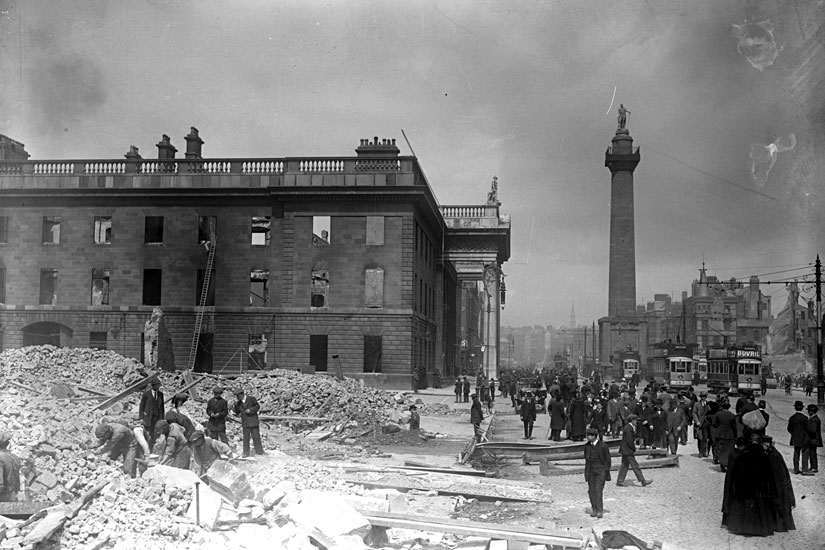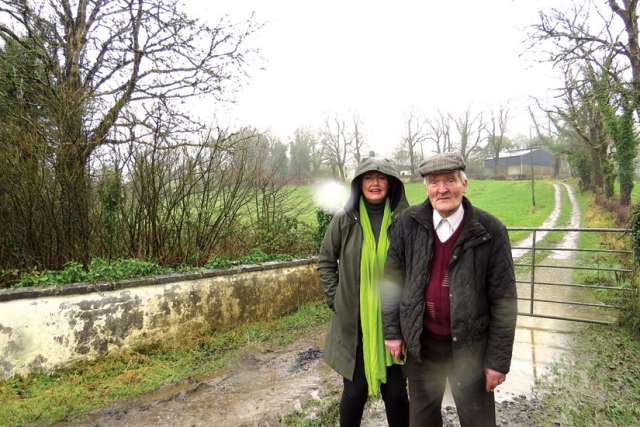With only lukewarm public support, the rebels were defeated after a week. But British retaliatory mistakes — like executing 16 rebel leaders, including one so close to dying he couldn’t stand and was tied to a chair before the firing squad — swung public sentiment and eventually led to Irish independence within five years.
In the cold and damp, 100 years later, I stood in the courtyard of the Kilmainham Gaol (pronounced jail) where the rebels died one by one. I could almost feel the ghosts.
All around Dublin, there is talk about the Uprising this year. There are walking tours to historic places like the General Post Office where Patrick Pearse read the Proclamation of the Republic on Easter Monday, 1916, at the start of the Rising. There’s even a walking tour where Michael Collins wandered unawares to the British for years after the Rising while carrying out guerilla war tactics on British soldiers.
 After the Easter Rising members of the public survey the damage done to the post office in Dublin during the rebellion. (Image from the National Library of Ireland)
After the Easter Rising members of the public survey the damage done to the post office in Dublin during the rebellion. (Image from the National Library of Ireland)
My wife Cobi and I went all in and booked a room at the historic Shelbourne Hotel overlooking St. Stephen’s Green, a Dublin park and a short-lived rebel stronghold. From our room we could see the view that British soldiers had as they rained down gunfire on the rebels from the hotel windows.
The Shelbourne also was where the drafting of the Irish Constitution took place in May, 1922. Cobi and I had tea in the very room this historic event took place.
With both our ancestry mostly Irish, we’d each longed to see the Emerald Island. For her birthday this year, we finally decided to go. We bookended our trip in Dublin and in between went out on a nine-day road trip to see where our ancestors came from and learn more about the country.
Along the way, we made some new friends, scratched an item off our bucket list and added a new one: “Go back to Ireland and see some of the things we missed.”
We also discovered firsthand that Ireland is a country of contradictions. For example, we all know about the historical “Troubles” between Catholics and Protestants. But how about this headscratcher: St. Patrick’s Cathedral in Dublin is Protestant and St. Patrick’s Church in Belfast is Catholic.
Speaking of which, St. Patrick’s colour was blue, not the green so familiar with Ireland. Green came into vogue about 225 years ago; some say for the lush green fields of Ireland, others say for the shamrock St. Patrick used to explain the Holy Trinity to the pagans he was converting to Christianity way back in the fifth century. Green may be the usual Irish colour, but St. Patrick’s blue is still found in symbols of both the state and the island, if you look for it.
How about this one: Not all the 1916 Easter Rising rebels were Catholic. Indeed, one of the rebel heroes was a woman commander who was born into the Protestant British aristocracy and married a Polish Count. Countess Constance Markievicz escaped execution because she was a woman and she went on to a cabinet post in the new Irish Republic.
Indeed, Irish broadcaster Sean Moncrieff published a book in 2015 entitled The Irish Paradox: How and Why We Are Such a Contradictory People.
One of Ireland’s most famous writers, Brendan Behan, put it another way: “It’s not that the Irish are cynical. It’s rather that they have a wonderful lack of respect for everything and everybody.”
That may be so, but we found they certainly have a great deal of respect for visitors. It’s incredible how friendly the people in Ireland can be. In yet another contradiction, Moncrieff argues: “We’re friendly, but near impossible to get to know.”
Nonetheless, while wandering the streets of Dublin, Belfast or Galway, if we stopped to look at a map, within seconds a stranger would ask if we needed help. And the Irish hospitality was always on display in hotels, bed and breakfasts, pubs and restaurants — even if they constantly assumed we were Americans by our accent.
We travelled to a village called Manorhamilton in County Leitrim to see if we could find the ancestral farmhouse of my wife’s family. We stopped in Gurn’s pub for a tasty lunch and started talking to the bartender, Claire Connolly, and a patron named Sean, who had an accent thicker than anything I’d heard in Newfoundland. (Apparently, a lot of Irish left County Leitrim and settled in Newfoundland in the 1800s.)
I asked Sean if he knew my wife’s distant relative, Cecil Davis, the last of her Irish line who died about 10 years ago. “Sure, I knew ’is fadder Alf, too,” he said.
Then he proceeded to tell us how to find the old abandoned farmhouse. We looked at each other dumbfounded because it was like he was speaking another language.
“Let me interpret for you,” Claire said, and then she started drawing a map based on Sean’s instructions.
“Oh,” Claire said, “Sean says he’ll take you out there. Just follow him in his blue van.” After Sean finished his stew, off we went and five kilometres later we were at the old Davis farm. We had a nice conversation about the Davis family and I was beginning to understand more of what Sean was saying — maybe 50 per cent. A friendly Irish encounter that would be replicated many times during the trip.
A few days later, we visited a pub in County Tipperary that was voted the best pub in Ireland despite being open only Thursday nights. It’s all about the traditional Irish music and the craic (Gaelic for fun) at this pub, which is really more like a house party.
This pub called Jim ’O the Mill was lively with tons of craic and our new friends invited us to join them the next night for more Irish folk music at the Kinnane Pub in nearby Upperchurch.
It turns out the founder of Kinnane’s Pub, Paddy Kinnane, was father of the current owners, and a good friend of Sean MacBride, formerly of the IRA who went on to win the Nobel Peace Prize for his human rights work. MacBride also happened to be the first famous person I interviewed as a journalist when he was in Toronto giving a speech in 1981. Sean’s dad, John, was one of the rebels executed in 1916.
Both Sean MacBride and Paddy Kinnane are dead now, but there hangs a picture of them in the pub and I had a good chat with Paddy’s son-in-law Jim Butler about that.
From the cobblestone streets of Dublin, to the traditional music in every pub in old Galway, to the rugged beauty of the Ring of Kerry to the Blarney Castle and its famous stone, there’s just something about Ireland and the Irish.
It’s little wonder why millions around the world pretend to be Irish for a day every year on March 17. If you go out and celebrate this year, wear something blue instead of green and ask your friends if they know why!
(Brehl is a writer in Port Credit, Ont., and can be reached at bob@abc2.ca or @bbrehl on Twitter.)
Exploring the Emerald Isle
Read other stories from Robert Brehl below:


